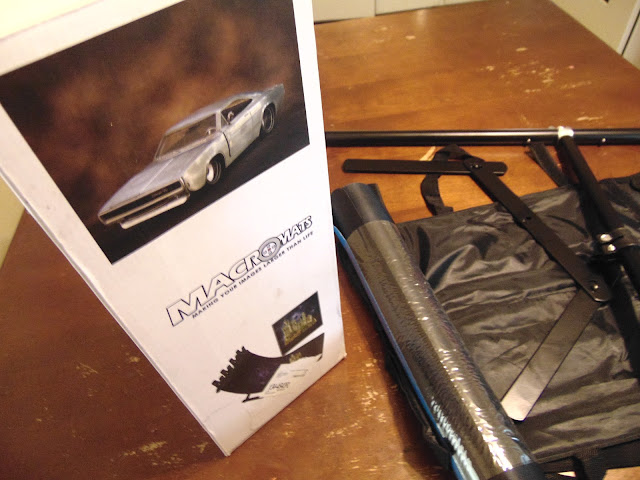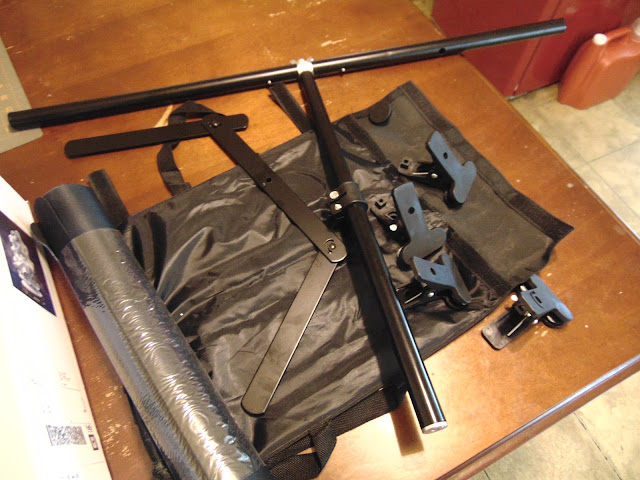I've played every version of Combat Patrol / Kill-Team in every edition since 3rd. It should go without saying that we'd also be taking on this version of the skirmish rules subset, but this edition is a little different. It's a full-blown game on it's own, and Games Workshop has really lavished production on this version.
So, in approaching Kill-Team I saw an opportunity to actually use some of the smaller sets I've managed to cling on to over the years but never blossomed into a real army. It would also serve as a place I could collect a few new models without the commitment required of a full army until I got ready to make that move. If ever. Instead, Kill-Team would be composed of DIFFERENT forces than my main 40k armies.
Kill-Team is one of the most anticipated games on our roster. As larger 40k forces require more time to muster, the Kill-Teams in my area are becoming activated. Almost every gamer I know has a Kill-Team, and if they don't they have friends they can borrow one from.
If you have a 40k army, then you have a Kill-Team. 40k aficionado? Collect a Kill-Team from a new army. If you're in the Iron Seer's area - prepare yourself. Kill-Team campaigns have been planned from the get-go!
We'll be using all the Kill-Team material from the Core, Commanders, Elites and the Kill-Team Annual 2019. Other Kill-Team materials will be considered, but by and large Arena will not be part of the program. Even so, plenty of Kill-Teamery to get caught up on in the meantime as we begin to explore a new corner of the 40k universe through our campaigns, armies and terrain building.
Get ready to carve out your own piece of the Nemesis Sector.
Sunday, April 19, 2020
Sunday, April 12, 2020
TableWar MacroMats
My photography kinda sucks, I know.
Working on that, but it's largely due to lighting in my workspace and my poor ability to have good lighting. Alternatively you can think of it as my good ability to have poor lighting - whichever is a greater positive in your mind. I do have a full studio light set, but nowhere to really set it up and leave it so I can get work done with it.
I've got small lamps, but can't seem to find the right bulbs to do the job. The only bulbs anyone seems to carry are off-white and...well, that's another story. Today I want to talk about steps I'm taking to fix the problem.
One thing I never really had was a background that was small. Yeah, there's an 8ft screen but I don't have spare room to set it up anymore...right now. And anyway, these days I'm not filming 6ft of people on a screen, but 35mm or less on a tiny backboard. I thought I'd check out TableWar Designs' MacroMats to see if I can actually be helped.
I took it out and after some flummoxing it for a bit I figured out what I was supposed to do just by looking at the pictures. It set up nice and easy and I must say I'm happy that it came with a carrying satchel. This will probably remain together most of the time if I can find a good place for it's footprint. Then again, it will hang easy in the closet in the satchel.
I actually like that I can set it up for the correct height or width I need for my shots. I've been playing around taking shots and I think this has already proven it will be a great boon for photos here on my blog going forward. Now I just have to work on my lighting...
As far as endorsements go, I'd say if you plan on taking a lot of photos of your models then this is a must-buy. The MacroMats set has everything you need in one handy kit, and you can't beat the convenience it provides with photo setup. Also, you could definitely use whatever backgrounds / materials on it that you'd like for your composition. This tool is now one of my 'essentials', for certain.
Working on that, but it's largely due to lighting in my workspace and my poor ability to have good lighting. Alternatively you can think of it as my good ability to have poor lighting - whichever is a greater positive in your mind. I do have a full studio light set, but nowhere to really set it up and leave it so I can get work done with it.
 |
| TableWar Designs MacroMats comes neatly packaged in a bag...inside a box. |
 |
| The contraption, disassembled. |
 |
| Warm background, with Frostgravy bois. |
 |
| Cool background, with more snowy-based minis. |
 |
| Light background, with rather suspicious looking ruffians lurking in the snow. |
Friday, April 10, 2020
AD&D 2e Combat Overview
Combat!
It's what's good for you...err, no. It's what's bad for everyone. However, for me, the tactical and strategic elements of certain games are part of the draw. The 'roll-play' if you will. Combat is one of those things where anything can happen, and you should be on your toes if your adventurers encounter a lot of battle.
...and they do, so...let's go over some of the basics and then a brief overview of combat.
AD&D Basics
- Ability Scores & Character Creation
- 4D6, drop the lowest, arrange as desired. Roll two sets, and choose between the two.
- If neither set is to your satisfaction, you can discard both and roll a new set.
- If you do not take the third set, you may discard it and roll a new set.
- For each set after the third, a cumulative -1 penalty must be assessed from any score in the set. For example, on the fourth set you must select 1 score and subtract one from it. The fifth set requires a total of -2 be assessed against the scores, and so on.
- You can dig this hole as deep as you like.
- Race, Class & Kits
- Your race and class dictate a lot about your character.
- Customization is further allowed through 'kits'.
- A kit is a template that is applied to your character, granting certain benefits and restrictions.
- THAC0, Saving Throws & Ability Checks
- There is no unified mechanic.
- THAC0 (to-hit armor class 0) Score is the score you need on a D20 (after modifiers) to hit Armor Class 0.
- Armor Class goes down. Basic armor class is 10. 0 is quite good.
- To get your required 'to-hit' score, simply subtract the target's armor class from your THAC0.
- Example: Fighter with THAC0 15 attacks an armored goon with armor class 4. Fighter will need an 11 (after modifiers) to hit the goon.
- Saving Throws are special defenses that are used when called for.
- Saving throws are determined by class, but invoked by spells and other special circumstances.
- To make a saving throw, roll a D20 and add any relevant bonuses.
- If you equal or exceed the required score, you succeed.
- Ability Checks are rolls made to perform special actions during an adventure.
- To make an Ability Check, roll a D20 and compare it to the Ability being utilized.
- If your roll is equal to or less than your Ability score (after modifiers) then the Check has succeeded.
- The amount by which an ability check succeeds is sometimes relevant. Therefore, it is best to get a low score.
- Weapon & Non-Weapon Proficiencies
- Proficiency Checks are rolls made to perform actions related to character proficiencies.
- The process is the same as an Ability Check, except each Proficiency may modify the Ability in question.
- Weapon Proficiencies can be spent on individual weapon proficiency, group weapon proficiency, weapon specialization and style specializations.
Timekeeping is a critical issue. Combat Rounds are LONG in AD&D 2e, that is to say, each round is one minute. That's between ten and twenty times the amount allotted in other systems! When you're used to a combat round that's three to six seconds in length, the time involved in your actions is the first thing to get used to. Your characters in AD&D 2e won't get as much done in 1 minute, so get over the idea that you will be able to make ten to twenty attacks in that time.
After that, it's the REST of the structure of the combat round.
Some example actions are given in the Player's Handbook (pg 93) and also examples of actions that one might recognize as 'free actions'. The time in each round given to your actions represents a lot of things happening in that small time, including the trading of blows, dodging, ducking behind cover, feints, dodges and probably smack talk.
Combat Sequence
- NPC / Monster Determination
- The DM determines all monster actions.
- Player Action Declaration
- The players indicated their intentions.
- Initiative
- 1D10 for each side / group.
- Individual modifiers for actions and bonuses apply for individual initiative.
- Attacks and Actions Resolved
- Lowest Initiative to highest. Low rolls are best.
Movement in Combat
- Facing
- A maximum of six combatants can fight any single opponent if all combatants are the same size.
- A creature has three 'front', 2 'flank' and 1 'rear' facing.
- Close to Combat
- A PC can move up to half their move rate in a round and still make a melee attack.
- Missile Fire & Movement
- A PC can move up to half their move rate in a round and engage in missile fire at up to half their normal fire rate.
- Charge
- A PC moves 150% of their move rate and makes a melee attack. Charging grants +2 to hit, and adds +2 to Initiative*. It also removes Dexterity bonuses to Armor Class from the charger. Further, the charger suffers -1 to Armor Class.
- Withdraw
- A PC moves away carefully from combat, up to 1/3 of his normal movement rate.
- Flee
- A PC who turns their back and runs can move up to his full movement rate. Opponents immediate get a 'free attack' on the fleeing character.
* RAW: The official rules state the opponent gets -2 to Initiative, but this is fiddly. Iron Seer rules the penalty applies to the charger in the form of +2.
Missile Weapons
- Range
- Attacks against targets at medium range suffer -2 to hit.
- Attacks against targets at long range suffer -5 to hit.
- Rate of Fire
- Up to three small thrown weapons can be thrown in a round.
- Up to two arrows can be shot in a round.
- Firing Into Melee
- Targets randomly determined based on size.
- Taking Cover
- Cover and Concealment are different things. Concealment is basically 'light cover' while Cover is 'hard cover'.
- The penalty is based on the amount of the target obscured and whether or not it's concealent or cover.
- An attack against a target that is 25% hidden suffers -2 if in cover and -1 if concealed.
- An attack against a target that is 50% hidden suffers -4 if in cover and -2 if concealed.
- An attack against a target that is 75% hidden suffers -7 if in cover and -3 if concealed.
- An attack against a target that is 90% hidden suffers -10 if in cover and -4 if concealed.
Parrying
- By forgoing all other actions (including movement) and concentrating on defense, a character gains an Armor Class bonus equal to half their level. A Warrior class PC gains an Armor Class bonus equal to half their level +1.
- (Complete Fighter's Handbook) Alternatively, a character can elect to parry attacks by expending attacks.
Healing
- A character is incapacitated at 0 hit points.
- Each round, an incapacitated character loses 1 hit point unless tended to for 1 round.
- A character dies when their hit point total reaches -10.
- Natural healing occurs at a rate of 1 hit point per day of rest.
- Complete bed rest heals 3 hit points per day.
- Complete bed rest for a full week grants an additional hit point recovery equal to the Constitution hit point bonus.
- On a natural 20, PC's and certain monsters score a critical hit.
- Roll damage dice twice, add bonuses once to obtain the final damage number.
Morale
- Monsters and NPC's have morale ratings and may flee combat if it is going poorly. This applies to all monsters and NPCs.
- Specific triggers in combat call for morale checks. Mostly, this is to see if a creature or force routs and flees from combat.
- To make a morale check, 2D10 is rolled against the creature's current morale rating. If it is equal or less after modifiers, the combatant is unaffected.
- Some monsters and NPCs may not have to check morale and thus are not subject to routing in this manner. These special creatures may or may not have another trigger / action altogether. Be wary.
Special Maneuvers
- The following special maneuvers are found in the Complete Fighter's Handbook.
- Called Shot
- By taking a -4 to-hit roll and a +1 penalty to initiative, a warrior can direct an attack at specific body parts or something held in the hand.
- Special results can be generated by using called shots.
- Alternatively, called shots can be the only way PC's can bypass an enemies defenses.
- Disarm
- A variant of the called shot. One-handed weapons are easier to disarm than two-handed weapons.
- Grab
- A variant of the called shot wherein you can grab an object.
- Hold Attack
- A combatant waits until later in the round to make their actions.
- Pin
- A called shot where the target's weapon or shield is trapped and cannot be used.
- Pull / Trip
- A normal attack roll that, if successful, forces the target to check against Dexterity or fall prone.
- Polearms
- Polearms can be set against charges, inflicting double damage.
- Polearms can be used to trip moving animals, or pull / trip targets further away.
- Sap
- A called shot with an additional -4 penalty (total -8 to-hit). If successful, the combatant rolls normal damage. For each point of damage there is a 5% chance (max 40%) that the blow incapacitates the target.
- 25% of this damage is normal, 75% is temporary damage that wears off shortly.
- Shield-Punch
- An attack with a shield that does 1D3 damage. Once a shield-punch is performed, the combatant loses the AC bonus for the rest of the round.
- Can be used with bucklers and small and medium shields.
- Shield-Rush
- A combination of Pull / Trip and Shield-Punch.
- Can be performed with a medium or body shield.
- Attacker must start at least 10 feet away.
- If the attack hits, it deals damage as Shield-Punch and the target must test against Dexterity or fall prone.
- The attacker may also fall prone. If the attack is successful, the attacker must test against Dexterity or fall prone. If the attack is unsuccessful, the attacker must test against Dexterity with a -6 penalty or fall prone.
- Surprise / Flash Maneuvers
- You can do whatever you can imagine. If it doesn't neatly fall under some other heading, the Dungeon Master may grant you a chance to perform some ridiculous stunt of daring and skill.
- You will be told of the circumstances during the game as the situation develops.
Subscribe to:
Posts (Atom)


